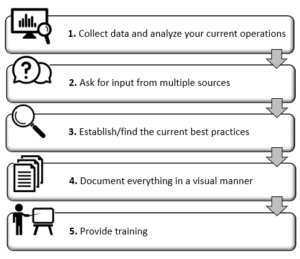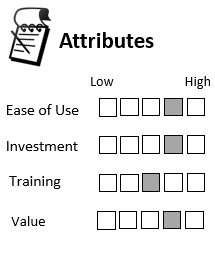Standard work is the identification of repetitive processes and activities to structure a baseline process for how to perform the identified task. The standard should optimize the defined task, to ensure a smooth handoff to reduce variability.
Application
To reduce variability and increase transparency work standardization provides a detailed process, inputs, tools and resources, and expected output.
By explaining each procedure’s steps and requirements, all involved workers can understand the process, remove unneeded waste, and can set a consistent baseline for performance.
Standard Work Overview

Best Practices
- Highly repetitive tasks such as assembly procedures are good candidates for standardization.
- Standards should reflect the current best-known method for completing a process.
Process
Identify your work sequence and Takt time as the first step. Then you can identify the most efficient method for performing the task.
To find the most efficient way to run your operations, lean tools such as Value Stream Mapping (VSM) can be used to optimize work sequence and procedures. By recognizing these procedures, you can ensure that operators follow each step, according to the best practice outlined by your standardized work.
Do
- Adopt a culture of continuous improvement.
- Visualize the benefits of Standard Work to encourage employees to participate in the process.
- Enable employees to provide feedback and take charge in process improvement.
Don’t
- Underestimate the importance of support from leadership.
- Neglect to continuously improve standards.
- Overcomplicate revision processes and change request forms.
Business Drivers
- Streamline problem-solving and process improvement.
- Ensure uniformity to certain practices.
- Simplify the training procedures for new employees.
- Lower operational costs.
Benefits
- Faster production.
- Higher quality of work.
- Happier employees.
- Increased customer satisfaction.
- Reduced variability and more predictable processes to ensure outcomes are near identical every time.
- Improve processes leading to better outcomes.

Complementary Methods
- A3 Thinking
- Value Stream Mapping (VSM)
- Visual Management
- Mistake-proofing (Poke Yoke)
Resources
- eBook: The Modern Guide to Standard Work, by Dr. Rebecca Morlando.
- Book: Transforming Design and Construction: Chapter on Work Structuring.